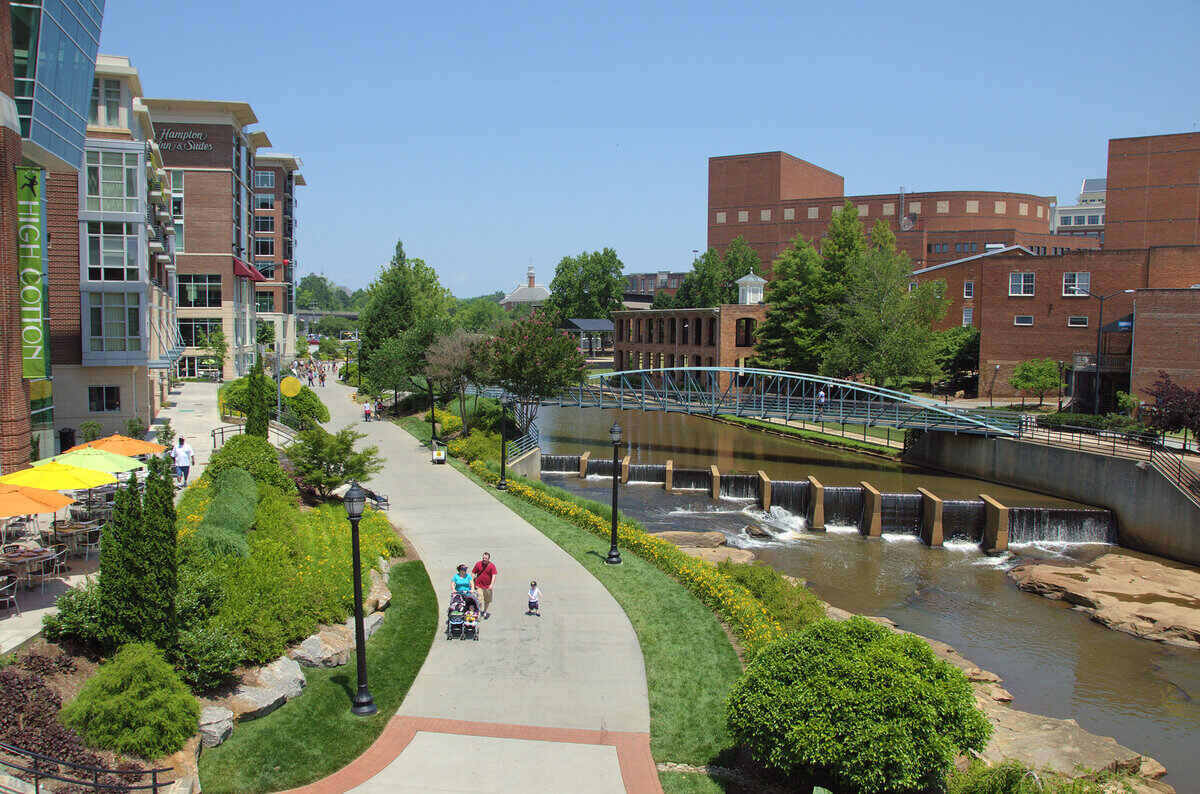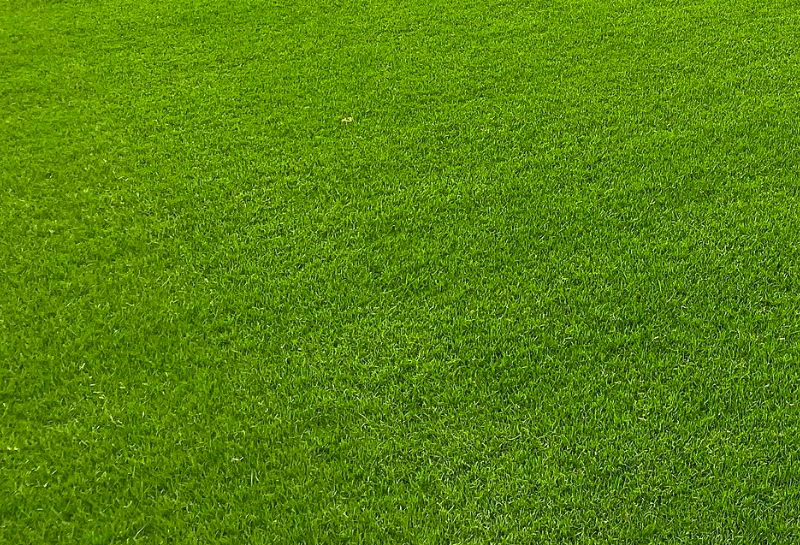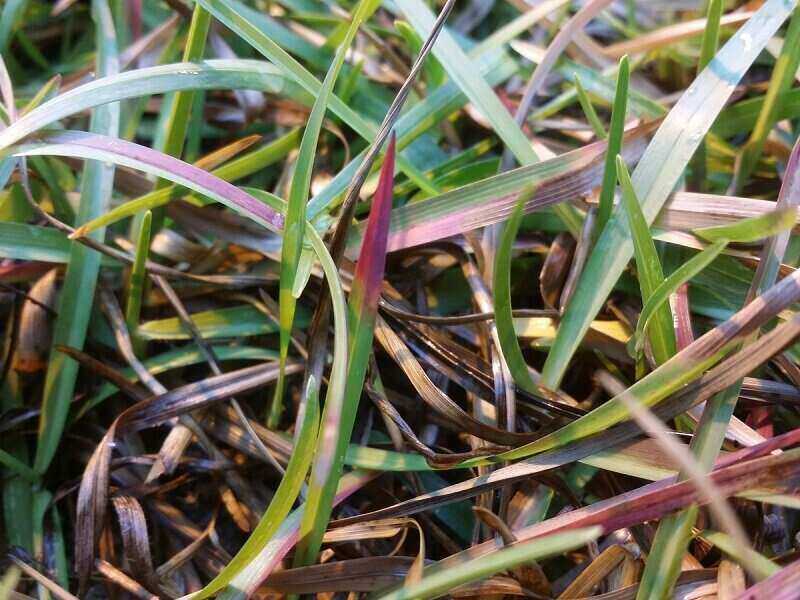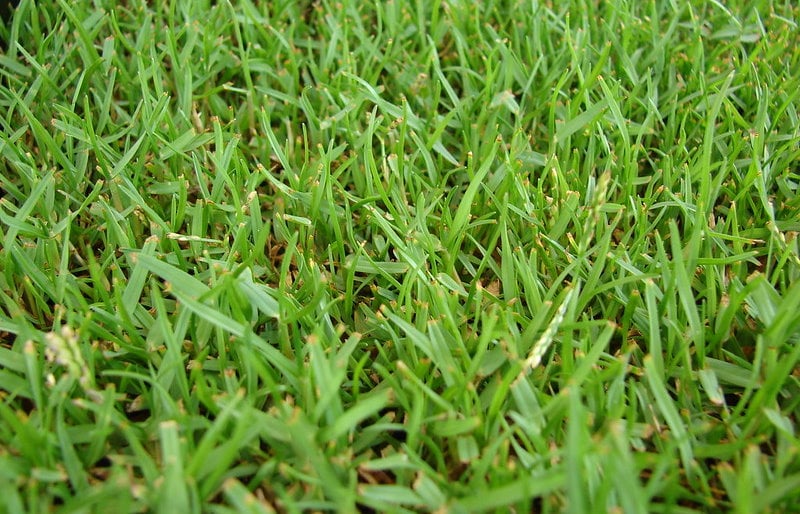
Greenville is nestled up against the foothills of the Blue Ridge Mountains and in South Carolina’s Upcountry. The city also sits right in the turf transitional zone, so there are many different cool-season and warm-season grasses that will do well in your yard.
These are our four top choices for Greenville area lawns:
1. Tall fescue

Ty Haller | Flickr | CC BY-SA 2.0
The nature of tall fescue is optimal for transition zones. It is both a cool-season grass and, surprisingly, extremely drought- and heat-tolerant. Its deep root system allows it to endure periods of low rainfall or little watering. Tall fescue requires less maintenance, so it’s a good alternative to other turfgrasses. It has low mowing, fertilization, and nutrient needs. Tall fescue even grows in clay soils.
Tall fescue has a medium to dark green color and coarse texture. If maintained correctly, tall fescue can keep its green color year-round. It has a high wear tolerance, so it is often found on sports fields, parks, and playgrounds.
- Classification: Cool-season grass
- Spreads by: Bunch-type
- Shade tolerance: High
- Drought tolerance: Moderate
- Foot traffic tolerance: Moderate
- Maintenance needs: Moderate
- Mowing height: 2 ½-3 ½ inches
- Potential for disease: Moderate. Fungal diseases such as crown rust often affect tall fescue under warm, moist conditions. Their roots are susceptible to nematodes, but tall fescue can tolerate damage caused by nematodes fairly well.
Other notes: Tall fescue has a hard time withstanding direct sunlight and summer temperatures for an extended period of time, so it is best grown in yards with partial shade.
Grass Seed Options:
– Triple-Play Tall Fescue Grass Seed Blend (5000 sq ft)
– Eretz Kentucky 31 K31 Tall Fescue Grass Seed (choose your size)
– Pennington The Rebels Tall Fescue Grass Seed Mix (7 lb.)
2. Bermudagrass

Gilba Solutions Pty Ltd | Wikimedia Commons | CC BY-SA 4.0
Commonly found on lawns throughout the South, bermudagrass is a medium-dark green, fine-textured, warm-season grass. It is a very tough, resilient turf. It is commonly used on sports fields and golf courses due to its ability to withstand and quickly recover from stress and damage caused by foot traffic.
Bermudagrass also can tolerate dry, salty, and humid conditions, so it makes it perfect for coastal locations. It also flourishes in places with full, direct sunlight, and can handle most types of soils.
Bermuda grass is a high-density turf grass with a high growth rate and weed-like tendencies. To avoid bermudagrass growing in undesirable areas such as flower beds, it’s best to mulch flower beds and other areas to maintain a barrier.
- Classification: Warm-season grass
- Spreads by: Stolons, and rhizomes
- Shade tolerance: Low
- Drought tolerance: High
- Foot traffic tolerance: High
- Maintenance needs: High
- Mowing height: ¾ -1 ½ inches
- Potential for disease: Low; however, bermudagrass does not tolerate nematodes as well as other turfgrasses
Grass Seed Options:
– Pennington Bermudagrass Bare Spot (5 lb. bag)
– Pennington Smart Seed Bermudagrass Mix (8.75-lb. bag)
– Scotts Turf Builder Bermudagrass (10-lb. bag)
– Hancock Seed Co. Bermudagrass (50-lb. bag)
3. Centipedegrass

Pxhere
Centipedegrass is found throughout the Southeastern United States. It is adapted to warmer climates and can thrive in coastal settings. It has a very bright green color and medium to coarse texture. In mild climates like Greenville, it can remain green all winter.
Although centipede grass is low-maintenance, it is vulnerable to foot traffic, and too much shade. It is also sensitive to certain herbicides. During times of drought, centipedegrass needs extra watering because its root system is very shallow.
Centipedegrass grows quite slowly, so blending it with other turfgrass may provide additional cover. It is also able to grow in poor soils but thrives in soils with a lower pH.
- Classification: Warm-season grass
- Spreads by: Stolons
- Shade tolerance: Moderate
- Drought tolerance: Moderate
- Foot traffic tolerance: Low
- Maintenance needs: Low
- Mowing height: 1 ½-2 inches
- Potential for disease: Moderate. Over-watering and/or too much fertilization increases the chance for diseases to develop.
Grass Seed Options:
– Gulf Kist Coated Centipedegrass Seeds (1 lb.)
– Scotts EZ Seed Patch and Repair Centipedegrass (3.75 lbs.)
– TifBlair Centipedegrass (5-lb. bag)
– Pennington Centipedegrass and Mulch (5-lb. bag)
4. Zoysiagrass

Forest and Kim Starr | Flickr | CC BY-SA 2.0
Native to Asia, Zoysiagrass is a group of turf grasses that include Japanese or Korean lawn grass (Z. japonica), Manilagrass (Z. Matrella), and Mascarenegrass or Korean velvet grass (Z. Tenuifolia).
Each one varies slightly from the other in color, growth, texture, density, and hardiness. Overall, Zoysiagrass is a versatile grass that can stand up to a variety of conditions. It’s known to withstand heat, drought, and heavy foot traffic. Because of its deep root system, Zoysiagrass can handle drought but will become dormant if it is exposed to dry conditions for too long. However, it recovers quickly after returning to normal watering conditions. Zoysiagrass can give you the beautiful, dense lawn you were looking for.
- Classification: Warm-season grass
- Spreads by: Rhizomes, and stolons
- Shade tolerance: High
- Drought tolerance: High
- Foot traffic tolerance: High
- Maintenance needs: High
- Mowing height: ¾-2 inches
- Potential for disease: Moderate. Because Zoysiagrass generally grows densely, invaders such as weeds have a difficult time growing in an already crowded area. Pests such as the Hunting billbug, nematodes, mole crickets, and white grubs can attack the Zoysia’s root system. Fungal diseases such as brown patch, dollar spot, and rust also plague Zoysia lawns.
Grass Plug and Seed Options:
– Zoysia Plugs (50 Large Grass Plugs)
– Zoysia Plugs (50 Full & Lush Grass Plugs)
– Zoysia Plugs (100 Plugs)
– Zoysia Emerald Grass Seeds (1/8 lb. of seeds)
– Zenith Zoysia Grass Seeds (1/8 lb. of seeds)
How to choose the best grass type for your Greenville lawn
These six grass types are well-suited and recommended for Greenville lawns, but you should consider a few things when deciding which one will best fit your lawn:
Homeowners with active families and pets should opt for bermudagrass. Those who want a lush, covered yard should consider Zoysiagrass varieties.
Keeping a lawn green comes with putting in time and money. Low-maintenance grass types, such as centipedegrass, can cut your cost and let you take back your weekends.
Yards with many mature trees and lots of shade would be ideal for tall fescue and Zoysia. If your lawn is open to direct sunlight, bermudagrass is your best choice.
Keeping these considerations in mind, you should be able to find which grass type is best suited for your Greenville lawn.
How to care for a “transition zone” lawn
Greenville is located in the turf transition zone, so lawns in this zone have the advantage of tolerating both cool-season and warm-season grasses. Cool-season grass will thrive in temperatures below 75 degrees and will remain dormant in the summer months and parts of spring. On the other hand, warm-season grasses can tolerate higher temperatures but will go dormant in the winter and have the potential to die during harsh freezes.
Overseeding with another grass type can help during periods of dormancy. During shoulder seasons — fall and spring — it’s important to prepare your lawn for the change in temperature and rainfall. You can overseed your existing warm-season grass with a cool-season grass, or if you have a cool-season grass type, you can overseed with a warm-season grass. This way, your grass can look robust all year long. Cool-season grass will keep the color in the fall and winter while the warm-season grass will sprout greenery in the spring and summer.
Need a lawn care service or landscaper? Contact a Greenville lawn care company to help with landscape design, installation, and maintenance.
Main Photo Credit: TimothyJ | Flickr | CC BY 2.0
Lawn Love participates in the Amazon Services LLC Associates Program, an affiliate advertising program. Lawn Love may earn revenue from products promoted in this article.